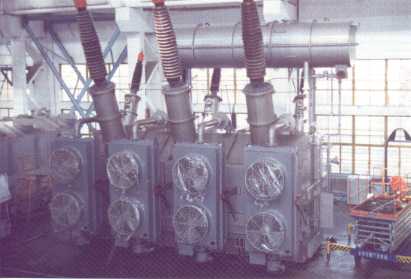Sections:
Transformers |
Circuit Breaker |
Switchgear |
Switchers |
Fuses
Power Transformers

Transformers for commercial and industrial electrical systems perform a wide range of functions. The category encompasses large units to many thousands of KVA for power.
Classifications Transformers maybe classified according to:
A. Type of Magnetic Circuit |
1. Stacked laminations |
a. Rectangular Core
b. Cruciform Core
c. Simple Shell
d. Distributed Shell |
2. Wound Core |
B. Number of Phases |
1. Single-Phase |
2. Three-Phase |
C. Arrangement of Windings |
1. Shell |
2. Core |
a. Cylindrical coils
b. Disk coils
c. Cylindrical and disk coils |
D. Methods of Cooling |
1. Natural convection and radiation
2. Air Blast
3. Oil-immersed self-cooled
4. Oil-immersed water-cooled
Forced-oil cooling |
E. Type of Service |
1. Constant Voltage |
a. Power Distribution
b. Instrument
c. Autotransformer |
2. Constant Current |
3. Induction Regulator |
a. Single-Phase
b. Polyphase |
F. Special Features |
1. Conservator |
2. Inertaire |
 Large transformers are usually installed outdoors as individual units or as part of a substation; indoors as individual units as part of a unit substation or in vaults. They transform high- or medium-voltage primary service to in-facility distribution voltage, usually 4.16 or 13.8 kV or transform primary service or distribution to utilization voltage, usually 480V, 480Y/227V, or 208Y/120V; occasionally 2400 or 4160V.
Large transformers are usually installed outdoors as individual units or as part of a substation; indoors as individual units as part of a unit substation or in vaults. They transform high- or medium-voltage primary service to in-facility distribution voltage, usually 4.16 or 13.8 kV or transform primary service or distribution to utilization voltage, usually 480V, 480Y/227V, or 208Y/120V; occasionally 2400 or 4160V.
Dry-type transformers are available up to 34.5kV, with impulse (BIL) ratings of 150kV or higher. Today, the 220°C insulation system is standard on all but the smallest units. Cast-coil dry transformers can withstand severe environments.
Liquid-type transformers are available with insulating fluids of silicone, high temperature paraffin derivatives and freon-type additives.
Specifications
Power transformers have rated constants such as (a) rated kVA; (b) Terminal Voltage, (c) Current; (d) Leakage Reactance ( a factor of the leakage flux, cross section and the number or turns); (e) Load Losses (the sum of resistance and eddy losses in all windings plus stray loss, also includes no-load loss); (f) Insulation (either liquid or gas such as petroleum-based or mineral oils, askeral, silicones, high-flash point hydrocarbons, clorinated benzenes, chloroflourocarbons, nitrogen, air, flourogases, Freon); (g) Cooling (including temperature rise, and temperature variations such as thermal transient conditions); (g) Regulation and Efficiency.
 Circuit Breakers
Circuit Breakers
Home |
PPD |
Sites |
ABdA |
Help |
E-mail

